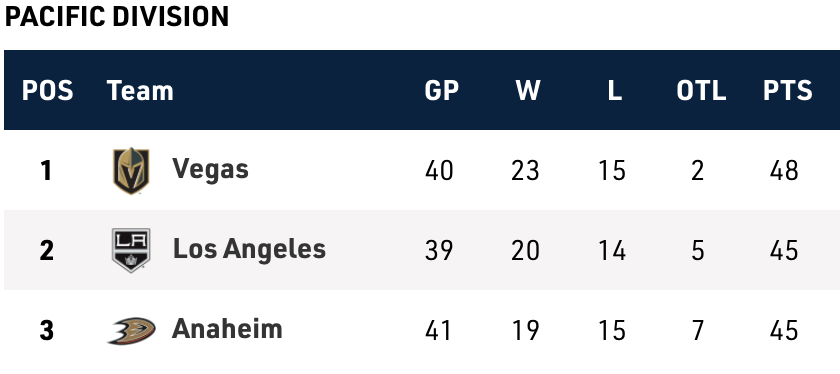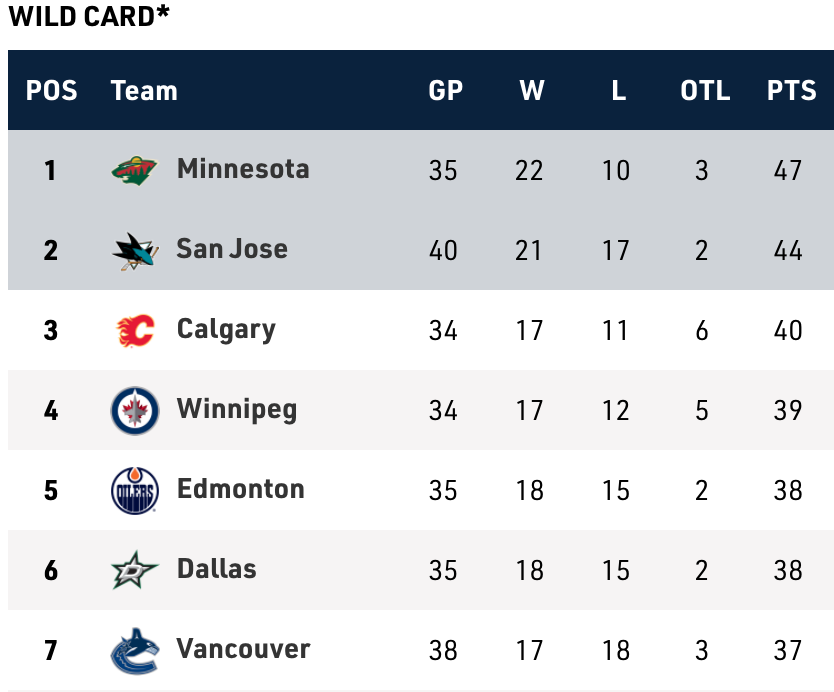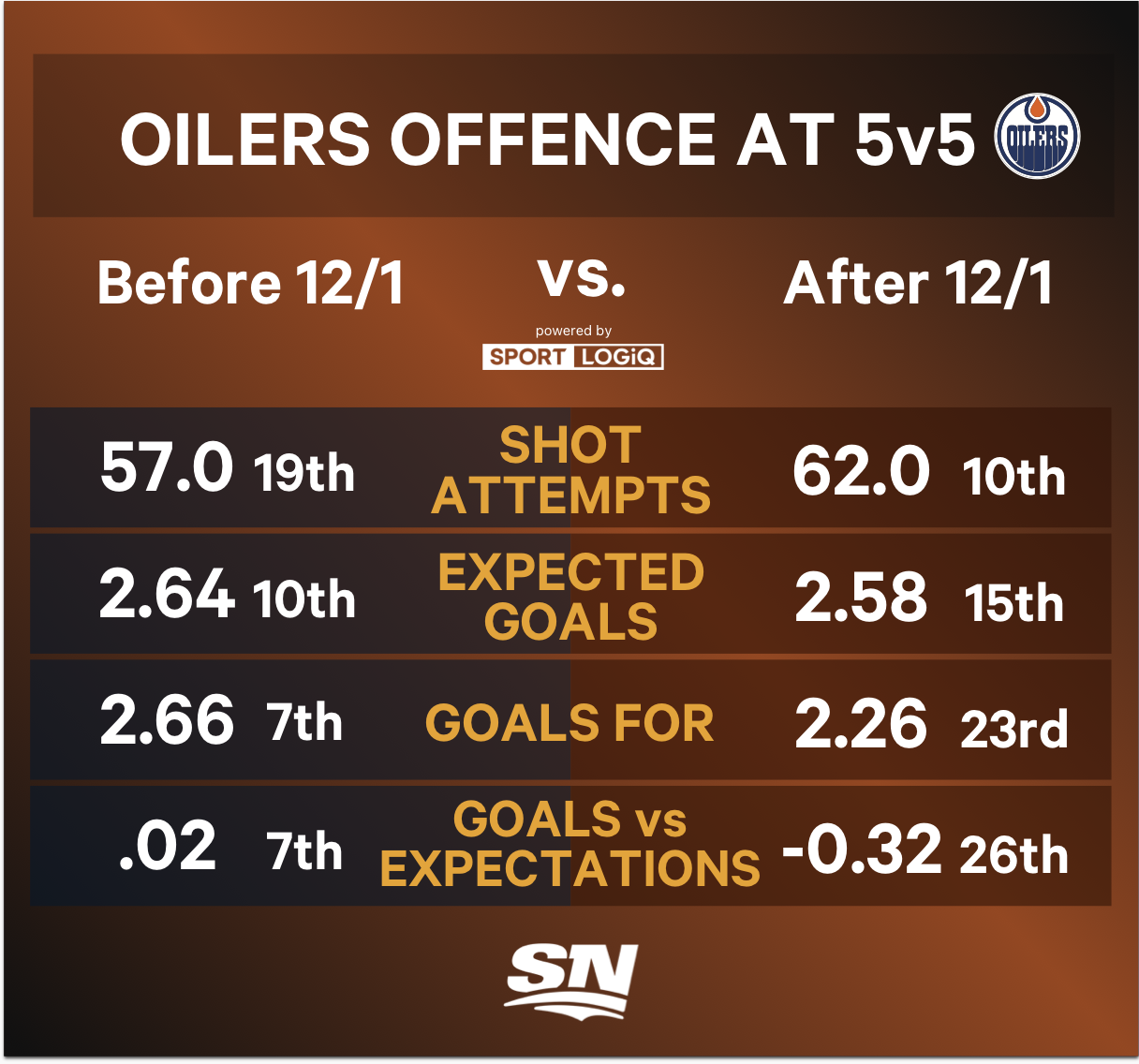What’s going wrong for the Oilers? The easier question, and shorter answer, may be finding what’s right.
Edmonton has a generational talent in Connor McDavid and one of the best scorers in the league in Leon Draisaitl. But it’s not enough to propel them to a Stanley Cup. That’s nothing new, though — this has been the story throughout both of their tenures, really.
[snippet id=5216510]
A contending team needs elite talent. They also need support around their best players. But because the Oilers haven’t found that, it rears its head at inconvenient times, and sometimes derails the team’s progress.
Right now, the Oilers are sitting sixth in the Pacific Division with an 18-15-2 record and 38 points. The divisional slots in playoff positioning currently belong to Vegas (48 points), Los Angeles (45 points), and Anaheim (45 points). Meanwhile, Minnesota leads the wild card race (47 points), followed by the Sharks (44 points). The Flames (40 points) and Jets (39 points) sit between Edmonton and San Jose.


Edmonton’s playoff chances depend on what model you look to. Evolving-Hockey is the most optimistic at 64.1 per cent, followed by MoneyPuck’s 58.6 per cent odds. Dom Luszczyszyn’s model at The Athletic trends slightly lower to 51 per cent, while HockeyViz gives the lowest chance of some of the ‘core’ models in the public sphere at 46.1 per cent.
Why do some models have them sliding in the wrong direction? Because of how much their level of play has dropped off as of late.
The Oilers are rocking a .267 point percentage since Dec. 1, after going 3-10-2 and earning just eight of a possible 30 points. The only team to earn less of their potential points over this span were the Montreal Canadiens at .192.
Unfortunately, Edmonton’s play below the surface doesn’t paint a more encouraging picture than the surface level.
To open the season, the Oilers appeared to be clicking offensively, and were fine enough in net for a time. The power play was on an unsustainable tear, but even when it came down to earth, there were signs it could still be successful.
At 5-on-5, their shot volume didn’t overwhelm, but they made up for it in quality. The Oilers got to the quality areas for slot attempts at the ninth-best rate in the league. Those scoring chances were generated both on the rush (where they ranked second in the league with 7.22 slot attempts per 60) and off the cycle (fifth with 8.14 slot attempts per 60).
Most importantly, they were finishing those chances. But it didn’t appear to be unsustainable, as their actual goals for rate was only .02 ahead of expectations.
Fast forward to their play after Dec. 1.
Edmonton’s actually creating more shots for, and there hasn’t been much of a change in their slot attempts either — though how they’re taking those scoring chances has slightly adjusted with fewer rush chances (down to 6.29 slot attempts on the rush per 60, which is 13th in the league over that span of time) and more shots off the cycle (8.47 per 60).
But, they’re scoring at a lower clip — and falling below expectations, unlike earlier in the season.

Pre-shot movement is an obvious consideration when a team isn’t scoring at as high of a rate, but there hasn’t been a noticeable change there either: the Oilers are still attempting a lot of passes in the offensive zone, connecting at a high rate, and moving the puck to the quality areas of the ice.
Right now, offensively, the issue seems clear: finishing.
McDavid or Draisaitl made up 30 per cent of the Oilers’ 5-on-5 goals before Dec. 1. And about three-quarters of the team’s scoring featured a point from McDavid and/or Draisaitl. But Draisaitl, who had a point on almost 42 per cent of the team’s scoring, has decreased by 10 per cent in this time. McDavid’s slipped by over seven per cent.
And it’s trickled into their play on the man-advantage, too.
That’s even more pronounced when the team can’t rely on its scoring depth to pick up the slack despite some improvements, like seeing growth from Jesse Puljujärvi and signing Zach Hyman.
What’s holding the Oilers back now is that their road to contention includes more than just forward improvement.
The blue line could use a boost, too — getting more puck-movers to play alongside Darnell Nurse and Evan Bouchard could make the gaps up front seem less glaring, at the very least.
But more than anything, their biggest weaknesses are further back in net.
The plan wasn’t to rely on Mikko Koskinen as much as they have, and injury forced this situation. That said, management knowingly went into the year with an ill-advised Mike Smith-Koskinen tandem that was flawed from the start.
The Oilers actually tightened up defensively after Dec. 1 at 5-on-5 to give their crease some more support — but the goalies didn’t respond well enough to that workload. Against 2.57 expected goals against per 60 to start the season (19th in the league), Edmonton’s goaltenders conceded .27 more than expected (26th). Since Dec. 1, their goaltenders have allowed .63 more goals than expected (29th) against the 2.35 xG rate against they face.
Expanding to all situations, the Oilers’ collective save percentage of .913 ranked 10th in the league in October and November. But since then, it’s dropped to .875 between Koskinen, Stuart Skinner, and a short appearance from Smith. The only team to have less stable goaltending has been New Jersey over that stretch.
The Oilers’ lack of finishing has stopped them from outscoring their goaltenders woes — but not having at least league-average netminding has been devastating, too.
So even if management hopes that Smith can recover and play a strong second half, they can’t rely on it. The answer to their crease has to be outside the organization, and that should be the first consideration as soon as possible.
And then, the Oilers still have the rest of the roster holes to tackle.
Data via Sportlogiq
[relatedlinks]







